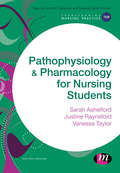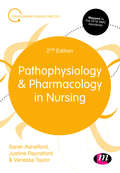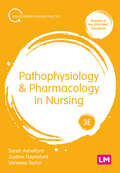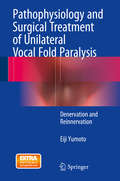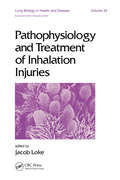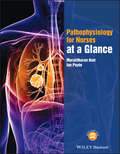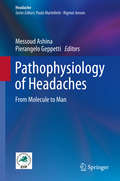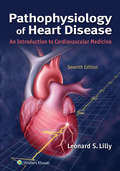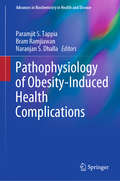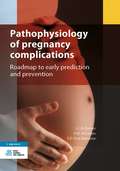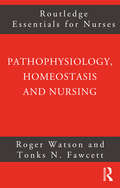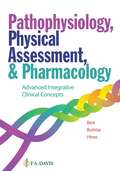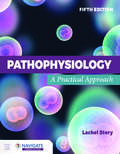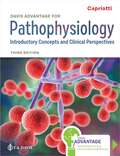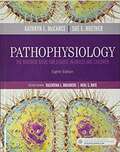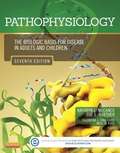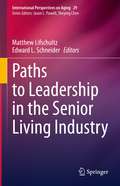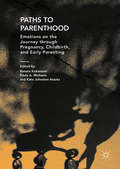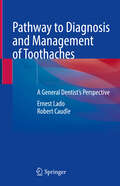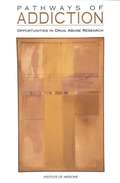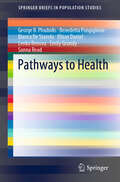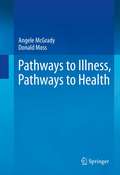- Table View
- List View
Pathophysiology and Pharmacology for Nursing Students (Transforming Nursing Practice)
by Sarah Ashelford Vanessa Taylor Justine RaynsfordCarefully designed to provide an integrated introduction to both the biology of disease and the therapeutic agents that are used to manage them, this book considers the underlying pathology of many common illnesses and diseases but by focusing on those conditions which have a pharmacological intervention is able to provide nurses with a broader understanding of bioscience that reflects care given in practice. It covers the basics of pharmacology, the core pathological concepts of inflammation, infection and cancer as well as a systems-based consideration of the pathophysiology and relevant pharmacology of common disorders. Providing the ideal starting point for student nurses to develop a robust, integrated knowledge of human disease and pharmacology, this book will enable them to provide care based on up-to-date knowledge of this important subject.
Pathophysiology and Pharmacology in Nursing (Transforming Nursing Practice Series)
by Sarah Ashelford Vanessa Taylor Justine RaynsfordPathophysiology and Pharmacology in Nursing has been carefully designed to provide an integrated introduction to both the biology of disease and the therapeutic agents that are used to manage them. It covers the basics of pharmacology, the core pathological concepts of inflammation, infection and cancer, as well as a systems based consideration of the pathophysiology and relevant pharmacology of common disorders. New to the second edition: All content updated and mapped to the 2018 NMC standards Two new chapters on ‘Mental health conditions’ and ‘Renal conditions. The ideal starting point for student nurses to develop a robust, integrated knowledge of human disease and pharmacology, enabling them to provide care that is based on up-to-date knowledge of this important subject.
Pathophysiology and Pharmacology in Nursing (Transforming Nursing Practice Series)
by Sarah Ashelford Vanessa Taylor Justine RaynsfordPathophysiology and Pharmacology in Nursing has been carefully designed to provide an integrated introduction to both the biology of disease and the therapeutic agents that are used to manage them. It covers the basics of pharmacology, the core pathological concepts of inflammation, infection and cancer, as well as a systems based consideration of the pathophysiology and relevant pharmacology of common disorders. New to the second edition: All content updated and mapped to the 2018 NMC standards Two new chapters on ‘Mental health conditions’ and ‘Renal conditions. The ideal starting point for student nurses to develop a robust, integrated knowledge of human disease and pharmacology, enabling them to provide care that is based on up-to-date knowledge of this important subject.
Pathophysiology and Pharmacology in Nursing (Transforming Nursing Practice Series)
by Sarah Ashelford Vanessa Taylor Justine RaynsfordWritten in clear language and specifically for the nursing context, the new edition of this bestselling book is your ultimate guide to pathophysiology and pharmacology. Through a uniquely integrated approach, the book develops your knowledge of both the pathology of common conditions and their pharmacological treatment. This holistic approach builds your knowledge of the key concepts and processes, with real world examples illustrating their application to nursing practice. Key features Logical structure that starts with the basics and before developing your understanding of more complex areas Real world case studies demonstrate the application of pathophysiology and pharmacology across all fields of nursing A clear and concise writing style makes complex terminology and biological processes easy to understand Revised and updated in line with contemporary evidence and best practice Mapped to the 2018 NMC Standards
Pathophysiology and Pharmacology in Nursing (Transforming Nursing Practice Series)
by Sarah Ashelford Vanessa Taylor Justine RaynsfordWritten in clear language and specifically for the nursing context, the new edition of this bestselling book is your ultimate guide to pathophysiology and pharmacology. Through a uniquely integrated approach, the book develops your knowledge of both the pathology of common conditions and their pharmacological treatment. This holistic approach builds your knowledge of the key concepts and processes, with real world examples illustrating their application to nursing practice. Key features Logical structure that starts with the basics and before developing your understanding of more complex areas Real world case studies demonstrate the application of pathophysiology and pharmacology across all fields of nursing A clear and concise writing style makes complex terminology and biological processes easy to understand Revised and updated in line with contemporary evidence and best practice Mapped to the 2018 NMC Standards
Pathophysiology and Surgical Treatment of Unilateral Vocal Fold Paralysis
by Eiji YumotoAll laryngologists, especially general ENT doctors who see patients with paralytic dysphonia, as well as speech pathologists, will benefit from this book's coverage of many basic and clinical aspects of reinnervation in retrieving patients' normal voices. Phonosurgical treatment for paralytic dysphonia was first established in the late 1970s in the form of arytenoid adduction and medialization laryngoplasty. It made possible the improvement of patients' post-op voices, but it was difficult to regain patients' own pre-paralysis voices. It has recently been established that immediate reconstruction of the recurrent laryngeal nerve during tumor extirpation is effective in recovery of their original voices in patients with unilateral vocal fold paralysis (VFP). The activity of the thyroarytenoid muscle is needed to recover normal voices. Nerve-muscle pedicle (NMP) flap implantation with a refined technique to the thyroarytenoid muscle is a novel method for that purpose. NMP flap implantation combined with arytenoid adduction was applied by the author to patients suffering from dysphonia and most patients did recover their nearly normal voices after surgery. This book provides readers with (1) what the currently prevalent surgical procedures are, (2) unsatisfactory results of these conventional procedures, (3) results of immediate recurrent laryngeal nerve reconstruction during tumor extirpation, (4) the outcome of delayed reinnervation combined with arytenoid adduction in patients with VFP and further, (5) the scientific basis that explains the reasons why the author's method is effective in the recovery of patients' own pre-paralysis, normal voices.
Pathophysiology and Treatment of Inhalation Injuries
by J. LokeThis book covers several aspects of inhalation toxicology ranging from inhalation drug abuse to battlefield chemical inhalation lung injury, and emphasizes pathophysiology and therapy.
Pathophysiology for Nurses at a Glance
by Ian Peate Muralitharan NairEverything you need to know about Pathophysiology... at a Glance! From the publishers of the market-leading at a Glance series, and from the authors of the successful Fundamentals of Applied Pathophysiology textbook comes the ideal revision guide for all the key diseases and conditions that nursing and healthcare students need to be aware of. Combining superb illustrations with accessible and informative text, this book is perfect for all nursing and healthcare students, and anyone who is looking for an overview of pathophysiology. Pathophysiology for Nurses at a Glance covers all the key diseases and disease processes affecting each body system, and key concepts encountered from the start of the pre-registration nursing or healthcare course. Key features: Superbly illustrated, with full colour illustrations throughout Written specifically for nursing and healthcare students with all the information they need Self-assessment questions provided for each chapter Pathophysiology for Nurses at a Glance is ideal for nursing and healthcare students as well as qualified practitioners, providing a comprehensive yet accessible overview of human pathophysiology.
Pathophysiology of Headaches
by Messoud Ashina Pierangelo GeppettiThis book provides a detailed overview of the current state of knowledge regarding the pathophysiology of both primary headaches - migraine, tension-type headache (TTH), and cluster headache - and the very important and frequent type of secondary headache, medication overuse headache (MOH). After an introductory chapter describing relevant neuroanatomy and vascular anatomy, the evidence gained from animal models regarding the pathophysiology of migraine and the other primary headaches is reviewed. Knowledge of the genetic component in the different types of headache is then examined with reference to recent evidence, for example regarding the implication of the trigeminovascular system and cortical spreading depression in migraine. Detailed information is provided on insights into primary headaches from imaging studies, including functional magnetic resonance imaging and positron emission tomography and on their neurophysiology and biochemistry. A further series of important chapters describe present knowledge of the pathophysiology of each specific type of headache and consider future directions. Written by acknowledged experts in their fields from Europe and the United States, clinicians and students will find Pathophysiology of Headaches to be an excellent source of up-to-date information on why patients experience headaches. In addition, it will be of value for pain researchers investigating the underlying mechanisms of headache.
Pathophysiology of Heart Disease: An Introduction to Cardiovascular Medicine
by Leonard S. LillyEnthusiastically acclaimed by medical students and faculty worldwide, this text is specifically designed to prepare students for their first encounters with patients with cardiovascular disease. Thoroughly revised by internationally recognized Harvard Medical School faculty and a team of select cardiology fellows and internal medicine residents, this seventh edition equips students with a clear, complete, and clinically relevant understanding of cardiovascular pathophysiology, setting a strong foundation for patient diagnosis and management.
Pathophysiology of Obesity-Induced Health Complications (Advances in Biochemistry in Health and Disease #19)
by Naranjan S. Dhalla Paramjit S. Tappia Bram RamjiawanAccording to the World Health Organization, the epidemic of global obesity has nearly tripled since 1975. In 2016, more than 1.9 billion adults were overweight, over 650 million of which were obese. Being overweight and obese has been linked to a number of non-communicable, chronic diseases. Pathophysiology of Obesity-Induced Health Complications is a compilation of review articles dedicated to describe co-morbidities associated with obesity. The wide range that is covered is of significant interest to basic research scientists, clinicians and graduate students who are engaged in studying obesity-induced health complications. Furthermore, this book highlights the potential of novel approaches for the prevention and treatment of obesity and its related illnesses. Nineteen articles in this book are organized in four sections that are designed to provide an overview of obesity-induced health complications. The first section serves as an introductory section on the prevalence, causes, consequences, treatments and preventive approaches for obesity. Section two covers the metabolic disturbances and inflammation due to obesity. The third section is focused on neurological and visceral complications as a consequence of obesity. The final section covers strategies for the prevention of obesity-induced complications. The book illustrates that obesity can result in a diverse range of pathophysiological conditions that adversely affect health.
Pathophysiology of Respiration
by Mieczyslaw PokorskiThis book presents a range of research and clinical contributions, including observational studies, practical treatment examples, diagnostic test assessment, biomarkers, and systematic reviews. The objective is to seek to explain the processes or mechanisms whereby abnormal or undesired conditions develop and progress. The attention is given to disturbed carbohydrate metabolism in perpetuation of respiratory ailments or raising therapeutic problems. The psychosocial context of chronic respiratory conditions is tackled as well. Oxidative stress is conducive to both physical and cognitive aging, which raises the specter of using its biochemical markers in future antiaging therapeutic strategies. Critical information provided in the contributions will allow readers to make informed judgments. The book will hopefully serve to create awareness and apprehension about the developments in the field of pneumology and related areas of medical research.
Pathophysiology of pregnancy complications
by L.L.H. Peeters P.W. de Leeuw E.D. Post UiterweerThis book provides an overview of the physiology of pregnancy and the pathophysiology of common pregnancy complications. Using this information, options are discussed for the early detection and prevention of these complications. <P><P> Chapter 1 outlines the maternal adaptation to pregnancy, which enables the fetus to grow, mature and thrive without compromising maternal health. Chapter 2 describes the pregnancy course in healthy women, who develop a common pregnancy complication, such as a placental syndrome, preterm birth or gestational diabetes. These complications are often superimposed on a latent defect in the cardiovascular, renal, immunologic and/or metabolic functions. Chapters 3 and 4 discuss pregnancy in women with a chronic disease that often affects one of these functions. Finally, chapter 5 uses the information provided in the preceding chapters to discuss the options for early detection and/or prevention of common pregnancy complications.<P><P> The emphasis of this book is on the pathophysiology of a complicated pregnancy rather than on its management. It explains the sequence of events that characterizes the development of common pregnancy complications. This insight is expected to assist in the deceision making and counseling by midwives and obstetricians of pregnant women, who at increased risk of these complications.
Pathophysiology, Homeostasis and Nursing (Routledge Essentials for Nurses)
by Roger Watson Tonks FawcettNursing students quite often find it difficult to relate what they learn with respect to normal and abnormal physiology to patient care. In this useful text Roger Watson and Tonks Fawcett clearly explain:* the concept of homeostasis* the relevance of physiology to common disorders* the patient's response to these disorders* the appropriate nursing response.Each chapter is presented in a standard format with a brief outline of the relevant normal physiology and how homeostatic mechanisms normally cope. The student is led to understand what the patient with a specific disorder feels like and why, and is clearly instructed in what nursing action to take. Pathophysiology, Homeostasis and Nursing shows clearly how understanding physiology can improve nursing care and covers the main issues that relate to basic observations. It includes questions to help the reader test their knowledge as they go along and provides an accessible concise text for health care students, particularly nurses.
Pathophysiology, Physical Assessment, And Pharmacology: Advanced Integrative Clinical Concepts
by Annette Hines F.A. Davis Company Janie Best Grace ButtrisIntegrate the 3Ps for a real-world, holistic approach to nursing care. This first-of-its-kind text integrates the 3 Ps—pathophysiology, pharmacology, and physical assessment—into an integrative whole that reflects the real-world of how students learn and nurses practice. This groundbreaking approach promotes a deeper understanding of these three essential and often challenging content areas, paralleling the importance of integration in the planning, delivery, and evaluation of nursing care. Its lifespan approach features six major population-based sections cover the key conditions and disorders that nurses are likely to encounter in practice, reviewing the important pathophysiology, pharmacology, and physical exam and assessment information relative to each disorder. Each section concludes with a case study that presents a new disorder relative to the population in that section, reinforcing the authors’ application-focused approach and developing must-have critical-thinking skills.
Pathophysiology: A Practical Approach
by Lachel StoryPathophysiology: A Practical Approach, Fifth Edition provides an innovative, practice-ready, approach to foundational pathophysiology for pre-licensure nursing students. The text is organized by body system and is presented in an easy-to-read format with vibrant graphics and practice tools. Dr. Story takes a student-focused approach to the challenging subject. She organized the content into topical chapters that walk students through their base knowledge of A&P, what can go wrong with the human body, how to identify it, and what to do about it. This st-udent-friendly approach empowers readers to take a more active role in learning pathophysiology. Students and faculty praise Pathophysiology: A Practical Approach for its innovative presentation, helpful Next Generation NCLEX-style questions, approachable reading style, dynamic images, and coverage of current research.
Pathophysiology: Introductory Concepts and Clinical Perspectives
by Theresa CapriottiDavis Advantage for Pathophysiology is a complete, integrated solution that combines a student-friendly textbook with personalized learning, clinical judgment, and quizzing assignments that engage learners, help them make the connections to key topics, prepare them for the Next Gen NCLEX®, and drive success. An access code inside new, printed textbooks unlocks an eBook, as well as access to Davis Advantage. Or, choose the all-digital Instant Access option which includes the eBook and immediate access to Davis Advantage. THE TEXTBOOK Chapters organized by body systems help students to understand the relationships between the underlying pathology and the patient assessment data, laboratory findings, and diagnostic testing results. Real-world perspectives bridge the gap between the science of disease and patient care.
Pathophysiology: The Biologic Basis for Disease in Adults and Children
by Sue E. Huether Kathryn L. McCanceLearn the what, how, and why of pathophysiology! With easy-to-read, in-depthdescriptions of disease, disease etiology, and disease processes, Pathophysiology: The Biologic Basis for Disease in Adults and Children, 8th Edition helps you understand the most important and most complex pathophysiology concepts. <p><p>This updated text includes more than 1,300 full-color illustrations and photographs to make it easier to identify normal anatomy and physiology, as well as alterations of function. This edition includes a NEW chapter on obesity and nutritional disorders, along with expanded coverage of rare diseases and epigenetics. It’s the most comprehensive and authoritative pathophysiology text available!
Pathophysiology: The Biologic Basis for Disease in Adults and Children (Seventh Edition)
by Kathryn L. Mccance Sue E. HuetherWritten by well-known educators Kathryn McCance and Sue Huether, and joined by a team of expert contributors, this resource is the most comprehensive and authoritative pathophysiology text available! A fully updated glossary includes 1,000 terms, and makes lookup easier by grouping together similar topics and terms. Outstanding authors Kathryn McCance and Sue Huether have extensive backgrounds as researchers and instructors, and utilize expert contributors, consultants, and reviewers in developing this edition. Chapter summary reviews provide concise synopses of the main points of each chapter. Consistent presentation of diseases includes pathophysiology, clinical manifestations, and evaluation and treatment. Lifespan content includes ten separate pediatric chapters and special sections with aging and pediatrics content. Algorithms and flowcharts of diseases and disorders make it easy to follow the sequential progression of disease processes. Nutrition and Disease boxes explain the link between concepts of health promotion and disease. EXTENSIVELY Updated content reflects advances in pathophysiology including tumor biology invasion and metastases, the epidemiology of cancer, diabetes mellitus, insulin resistance, thyroid and adrenal gland disorders, female reproductive disorders including benign breast diseases and breast cancer, and a separate chapter on male reproductive disorders and cancer. NEW! Chapter on epigenetics and disease. Additional What's New boxes highlight the most current research and clinical development.
Paths to Leadership in the Senior Living Industry (International Perspectives on Aging #29)
by Matthew Lifschultz Edward L. SchneiderThis book assembles many of the great leaders of the senior living and care industry to discuss their paths to and views on leadership. Each chapter provides readers with ideas, information, and inspiration on how to achieve leadership in this dynamic, mission-focused industry. It includes various strategies for success, such as promoting meaning and purpose in corporate culture, making decisions in the absence of perfect information, managing your personal assets of relationships and reputation, and finding competitive advantages through technology, training, and team-building. These leaders also share their experiences responding to COVID-19 and discuss how the pandemic may change the future of leadership in the industry. Whether your path starts in gerontology, nursing, social work, design, real estate, finance, law, operations, or technology, and whether one pursues work in the private, nonprofit, or government sectors, this volume provides a valuable resource for all aspiring and developing leaders in the senior living industry.
Paths to Parenthood: Emotions on the Journey through Pregnancy, Childbirth, and Early Parenting
by Renata Kokanović Paula A. Michaels Kate Johnston-AtaataThis interdisciplinary book explores the affective dimensions of becoming a parent, traversing the life-cycle journey of pregnancy, childbirth, and early parenting. Bringing together researchers from sociology, history, feminist studies, cultural studies, general medicine, and psychiatry, Paths to Parenthood analyses rich narratives that represent a diverse cross-section of parents, including migrants, same-sex couples, and single parents.
Pathway to Diagnosis and Management of Toothaches: A General Dentist’s Perspective
by Ernest Lado Robert CaudleThis book is a concise guide to the clinical examination and diagnosis of dental pain. It is focused on determining the root cause of pain to prevent an erroneous finding based on inadequate information provided by the patient or flawed interpretation of diagnostic testing. Readers will find guidance on anamnesis, clinical exams, and assessment of pain specific components of the mouth as well as on the progression of pulp diseases including the normal pulp, the inflamed pulp, necrobiosis and aerodontalgia. Information is provided on fractured tooth as well as on diagnostic tests for dental pain. The last part of the book is dedicated to periodontal pain and discusses the normal and inflamed periodontium, radicular periodontitis, apical periodontitis and endo-perio diagnosis. This book will be a help for all dentist as the diagnosis of toothaches can be complicated and present pedagogues fail to address the intricacies involved in the etiology of clinical signs and symptoms.
Pathways Of Addiction: Opportunities In Drug Abuse Research
by Committee on Opportunities in Drug Abuse ResearchDrug abuse persists as one of the most costly and contentious problems on the nation's agenda. Pathways of Addiction meets the need for a clear and thoughtful national research agenda that will yield the greatest benefit from today's limited resources.The committee makes its recommendations within the public health framework and incorporates diverse fields of inquiry and a range of policy positions. It examines both the demand and supply aspects of drug abuse.Pathways of Addiction offers a fact-filled, highly readable examination of drug abuse issues in the United States, describing findings and outlining research needs in the areas of behavioral and neurobiological foundations of drug abuse. The book covers the epidemiology and etiology of drug abuse and discusses several of its most troubling health and social consequences, including HIV, violence, and harm to children.Pathways of Addiction looks at the efficacy of different prevention interventions and the many advances that have been made in treatment research in the past 20 years. The book also examines drug treatment in the criminal justice setting and the effectiveness of drug treatment under managed care.The committee advocates systematic study of the laws by which the nation attempts to control drug use and identifies the research questions most germane to public policy. Pathways of Addiction provides a strategic outline for wise investment of the nation's research resources in drug abuse. This comprehensive and accessible volume will have widespread relevance--to policymakers, researchers, research administrators, foundation decisionmakers, healthcare professionals, faculty and students, and concerned individuals.
Pathways to Health (SpringerBriefs in Population Studies)
by George B. Ploubidis Benedetta Pongiglione Bianca De Stavola Rhian Daniel Lenka Benova Emily Grundy Sanna ReadThis book presents a rigorous enquiry into life course processes that are thought to influence health, integrating the latest methodologies for the study of pathways that link socio-demographic circumstances to health with an emphasis on the mediating factors that lie on these pathways. Following an introductory chapter on the application of formal mediation methods within the life course framework, the book offers insights on the pathways that link early life socio-economic circumstances to physical activity in later life, the role of physical activity as a moderator and/or mediator of the association between fertility history and later life health and the evolution of self-rated health over the life course in two generations born 12 years apart in 20th century Britain. Pathways to Health presents a dynamic view on how to investigate specific hypotheses within the life course framework and enhances the ability of the social science community to investigate specific mechanisms related to public health interventions.
Pathways to Illness, Pathways to Health
by Angele Mcgrady Donald MossThis book, designed for professionals, introduces a psychobiological model for understanding the paths that lead people to illness and provides recommendations for alterations of maladaptive pathways so that health is regained. Research findings are incorporated to identify causal variables for illness that can be targets for change. Evidence based recommendations for healthy behaviors and therapies are described. Throughout the book, the authors emphasize recognition of turning points on the path to illness that, through informed decision making and implementation of behavioral change, can be re-directed to pathways to health. This book presents case material to illustrate the directions that lead people to illness or to health. The pathways metaphor provides an organizing force, both in addressing variables contributing to illness onset, and in identifying interventions to restore health. This approach will guide the clinician to understanding how people become ill and the types of interventions that are appropriate for stress related illnesses. The clinician will also become better informed about ways to help clients make better decisions, mobilize clients' survival skills, and implement an interactive model of care. The book includes chapters on stress-related illnesses with high prevalence in today's society. For each illness, the genetic-psychobiological etiology is explored with enough detail so that the clinician understands the best method of patient assessment and treatment. One of the strengths of the book is the step-wise system of interventions that are applied to the stress-related illnesses. Beginning with re-establishment of normal daily psychobiological rhythms and continuing to evidence based state of the art interventions, the professional is presented with detailed intervention plans. For example, the section on "Applications to common illnesses: metabolic disorders of behavior: diabetes, hypertension, and hyperlipidemia" considers the confluence of genetics, behavior, and maladaptive mind body interactions to produce the metabolic syndrome. Then the personal and professional assessments are described to establish the baseline for recommending treatment while fully engaging the patient. Finally, multilevel interventions are formulated for these disorders. The plan begins with clinician guided self care recommendations to re-establish the normal rhythm of appetite and satiety. The next level of interventions consists of skill building techniques, such as relaxation and imagery. Lastly, psychotherapy and advanced applied psychophysiological interventions are detailed. Case examples are used throughout to illustrate the pathways to illness, the turning points, and the pathways to health. From the patients' viewpoints, the pathways metaphor is a motivator. The patient is guided to understand the paths that led to illness. Subsequently, the patient becomes empowered by the pathways framework to begin to make choices that lead to health.
